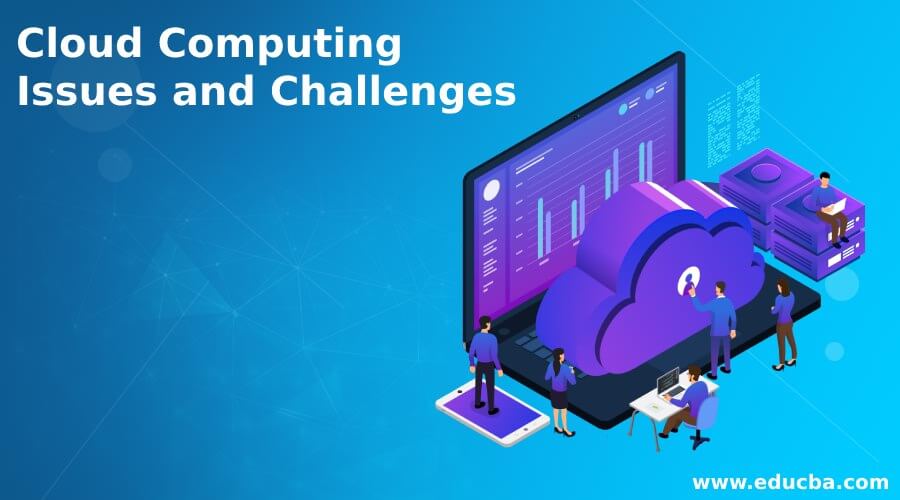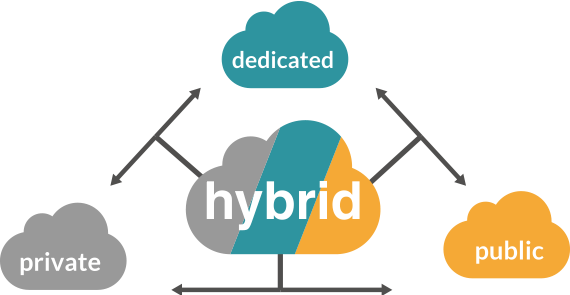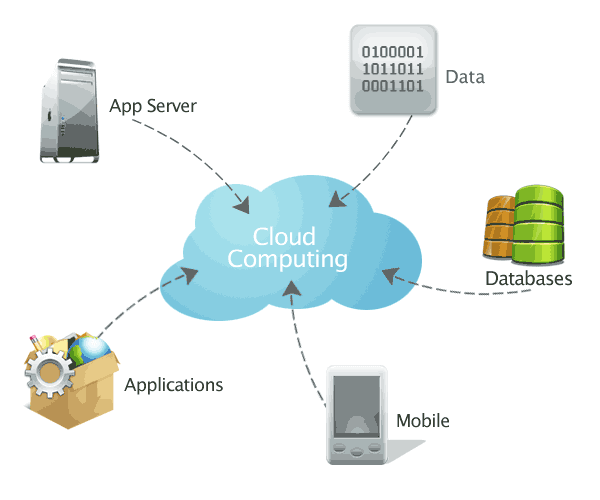Updated June 9, 2023

Introduction to Cloud Computing Issues and Challenges
Cloud computing is a common term you hear about on and off. And professionals use it without even knowing about the actual concept. So to put it in simple words, it is storing, accessing, and managing huge amounts of data and software applications over the internet. In this technology, the entire data is secured by firewall networks. You can use the Software without using your computer’s hard drive, as the Software and data are installed in worldwide data centers.
Many people use cloud technology in their daily lives. Using web-based email services or preparing any document over the internet is a typical example of cloud technology. In the IT industry, there are three different types of cloud computing such as infrastructure as a service (IaaS), platform as a service (PaaS), and Software as a service (SaaS). These cloud technologies are being used for different kinds of services. Cloud technology is beneficial in business development as it brings astonishing results in a timely manner.
However, there is a minor gap between success and failure in businesses. Selection of the right technology takes your business to new heights, while a few mistakes land your business in trouble. Every technology comes with baggage of some pros and cons. Similarly, it too comes with its share of issues despite being a core strength of some business industries. It also can create some major problems under some rare circumstances. Issues and challenges of cloud computing are characterized as ghosts in the cloud. Let us talk in brief about some real-life ghosts of cloud computing.
Real-Life Ghosts of Cloud Computing
Here we have discussed some real-life ghosts of cloud computing.
1. Data Security concern
When we talk about the security concern of cloud technology, many questions remain unanswered. Multiple serious threats like virus attacks and client site hacking are the biggest cloud computing data security issues. Entrepreneurs must consider these issues before adopting cloud computing technology for their business. Since you are transferring your company’s important details to a third party, it is important to ensure yourself about the manageability and security system of the cloud.
2. Selecting the perfect cloud setup
Choosing the appropriate cloud mechanism per your business’s needs is very necessary. There are three types of clouds configuration such as public, private, and hybrid. The main secret behind successful cloud implementation is picking up the right one. You may face severe hazards if you do not select the right cloud. Some companies have vast data and prefer private clouds, while small organizations usually use public clouds. A few companies like to go for a balanced approach with hybrid clouds. Choose a cloud computing consulting service that is aware of and discloses the terms and conditions regarding cloud implementation and data security.
3. Real-time monitoring requirements
In some agencies, it is required to monitor their system in real-time. It is a compulsory term for their business that they continuously monitor and maintain their inventory system. Banks and some government agencies need to update their system in real-time, but cloud service providers cannot match this requirement. This is a big challenge for cloud service providers.
4. Resolving the stress
Every organization wants to have proper control and access to the data. Handing your precious data to a third party is not easy. The central tension between enterprises and executives is their desire to control the new modes of operations while using technology. These tensions are not unsolvable, but they suggest that providers and clients alike must deliberately address a suite of cloud challenges in the planning, contracting, and managing of the services.
5. Reliability on new technology
It is a fact of human nature that we trust the things present in front of our eyes. Usually, entrepreneurs hesitate to let out organizational information to any unknown service provider. They think information stored in their office premises is more secure and easily accessible. By using cloud computing, they fear losing control over the data. They believe that data is taken from them and handover to an unknown third party. Security threats increase because they do not know where the information is stored and processed. These frights of the unknown service providers must very amicably be dealt with and eliminated from their minds.
6. Dependency on service providers
You must acquire vendor services with proper infrastructural and technical expertise for uninterrupted services and adequate working. An authorized vendor who can meet the security standards set by your company’s internal policies and government agencies. While selecting the service provider, you must carefully read the service level agreement and understand their policies and terms and provision of compensation in case of any outage or lock-in clauses.
7. Cultural obstacles
The high authority of the company and organizational culture have also become a big obstacle in the proper implementation of cloud computing. Top authority never wants to store the company’s essential data somewhere else where they cannot control and access the data. They have misconceptions that it puts the organization at risk by seeping out essential details. Their mindset is such that the organization is on risk-averse footing, which makes it more reluctant to migrate to a cloud solution.
8. Cost barrier
You have to bear the high bandwidth charges for efficient working of this. Businesses can cut down the hardware cost, but they must spend a lot on bandwidth. The cost is not a big issue for smaller applications but is a primary concern for large and complex applications. It would be best to have sufficient bandwidth to transfer complex and intensive data over the network. This is a major obstacle for small organizations, which restricts them from implementing cloud technology in their business.
9. Lack of knowledge and expertise
Every organization does not have sufficient knowledge about implementing cloud solutions. They have no expert staff and tools for properly using cloud technology. Delivering the information and selecting the right cloud is challenging without the right direction. Teaching your staff about the process and tools of cloud computing is a huge challenge. Requiring an organization to shift their business to cloud-based technology without proper knowledge is like asking for disaster. They would never use this technology for their business functions.
10. Consumption basis services charges
Cloud computing services are on-demand, so it isn’t easy to define the specific costs for a particular quantity of services. These types of fluctuations and price differences implement cloud computing complicated. It is difficult for a normal business owner to study consistent demand and changes with the seasons and various events. So it is hard to budget for a service that could consume several months of budget in a few days of heavy use.
11. Alleviate the risk of the threat
Certifying that the cloud service provider meets security and threat risk standards is very complicated. Every organization may not have enough mechanisms to mitigate these types of threats. Organizations should observe and examine the threats very seriously. There are mainly two types of threats: internal threats within the organizations and external threats from professional hackers seeking important information about your business. These threats and security risks put a check on implementing cloud solutions.
12. Unauthorised service providers
It is a new concept for most business organizations. An ordinary businessman is not able to verify the genuineness of the service provider agency. It’s difficult for them to check whether the vendors meet the security standards. They do not have an ICT consultant to evaluate the vendors against the worldwide criteria. It is necessary to verify that the vendor must be operating this business for a sufficient time without having any negative record in the past. The vendor continues business without any data loss complaints and has several satisfied clients. The market reputation of the vendor should be unblemished.
13. Hacking of brand
It carries some major risk factors like hacking. Some professional hackers can hack the application by breaking the efficient firewalls and stealing the organizations’ sensitive information. A cloud provider hosts numerous clients; each can be affected by actions taken against any one of them. When any threat comes into the central server, it affects all the other clients. In a distributed denial of service attacks, server requests inundate a provider from widely distributed computers.
14. Recovery of lost data
Cloud services face the issue of data loss. A proper backup policy for data recovery must be placed to deal with the loss. Vendors must set proper infrastructures to handle server breakdowns and outages efficiently. All cloud computing service providers must set up their servers at economically stable locations where they should have appropriate arrangements to back up all the data in at least two places. Ideally, they should manage a hot backup and a cold backup site.
15. Data portability
Every person wants to leverage migrating in and out of the cloud. Ensuring data portability is very necessary. Usually, clients complain about being locked in the cloud technology from where they cannot switch without restraints. There should be no lock-in period for switching the cloud. Cloud technology must have the capability to integrate efficiently with the on-premises. The clients must have a valid contract of data portability with the provider and an updated copy of the data to switch service providers, should there be any urgent requirement.
16. Cloud management
Managing a cloud is not an easy task. It consists of a lot of technical challenges. A lot of dramatic predictions are famous about the impact of cloud computing. People think that traditional IT departments will be outdated, and research supports the conclusion that cloud impacts are likely to be more gradual and less linear. Cloud services can easily change and be updated by business users. It does not involve any direct involvement of the IT department. A service provider is responsible for managing the information and spreading it across the organization. So it isn’t easy to manage all the complex functionality of cloud computing
17. Dealing with lock-ins
Cloud providers have a significant additional incentive to attempt to exploit lock-ins. A prefixed switching cost is always there for any company receiving external services. Exit strategies and lock-in risks are primary concerns for companies looking to exploit cloud computing.
18. Transparency of service provider
There is no transparency in the service provider’s infrastructure and service area. You cannot see the exact location where your data is stored or being processed. It is a big challenge for an organization to transfer its business information to an unknown vendor.
19. Transforming the data into the virtual setup
The transition of business data from a premise to a virtual setup is a significant issue for various organizations. Data migration and network configuration are the severe problems behind avoiding cloud computing technology.
20. Popularization
The idea of the cloud has been famous that there is a rush to implement virtualization amongst CIOs. This has led to more complexities than solutions. These are some common problems regarding cloud computing execution in real life. But the benefits of cloud computing are vaster in comparison to these hazards. So you should find the perfect solutions and avail the tremendous benefits of cloud technology in your business. It can take your business to new heights!!
Recommended Articles
This has been a guide to Cloud Computing Issues and Challenges. Here we have discussed the basic concept and real-life ghosts of cloud computing with a detailed explanation. You may also look at the following articles to learn more –






